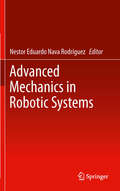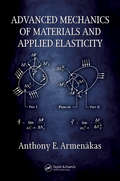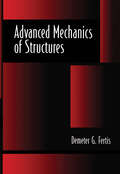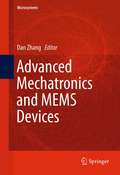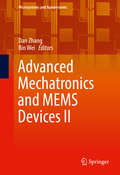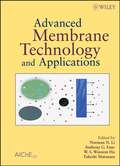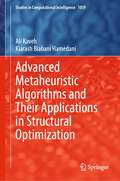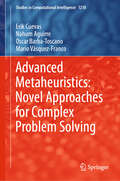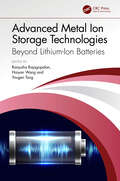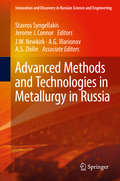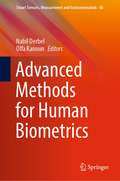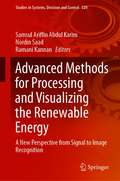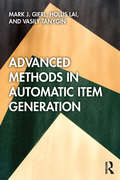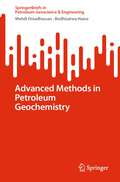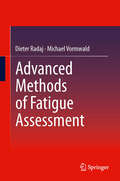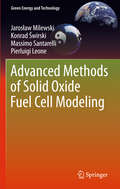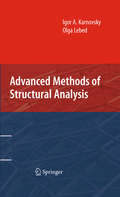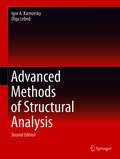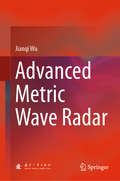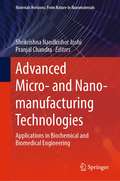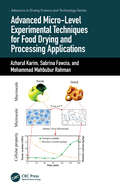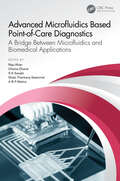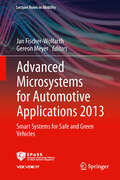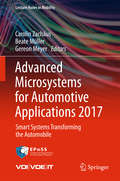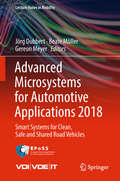- Table View
- List View
Advanced Mechanics in Robotic Systems
by Nestor Eduardo Nava RodríguezHumans have always been fascinated with the concept of artificial life and the construction of machines that look and behave like people. As the field of robotics evolves, it demands continuous development of successful systems with high-performance characteristics for practical applications. Advanced Mechanics in Robotic Systems illustrates original and ambitious mechanical designs and techniques for developing new robot prototypes with successful mechanical operational skills. Case studies are focused on projects in mechatronics that have high growth expectations: humanoid robots,robotics hands,mobile robots,parallel manipulators, andhuman-centred robots.A good control strategy requires good mechanical design, so a chapter has also been devoted to the description of suitable methods for control architecture design. Readers of Advanced Mechanics in Robotic Systems will discover novel designs for relevant applications in robotic fields, that will be of particular interest to academic and industry-based researchers.
Advanced Mechanics of Materials and Applied Elasticity
by Anthony E. ArmenakasThis book presents both differential equation and integral formulations of boundary value problems for computing the stress and displacement fields of solid bodies at two levels of approximation - isotropic linear theory of elasticity as well as theories of mechanics of materials. Moreover, the book applies these formulations to practical solutions
Advanced Mechanics of Structures
by Demeter G. FertisThis work details general theories and reliable analysis techniques for solving real-world problems in linear and non-linear mechanics. This book looks at the structural and mechanical behaviour of components such as beams, frames and plates of both uniform and variable stiffness in terms of both stress and deformation. It also emphasizes the challenging demands of industry. College or university bookstores may order five or more copies at a special student price, available on request from Marcel Dekker, Inc.
Advanced Mechatronics and MEMS Devices (Microsystems #23)
by Dan ZhangAdvanced Mechatronics and MEMS Devicesdescribes state-of-the-art MEMS devices and introduces the latest technology in electrical and mechanical microsystems. The evolution of design in microfabrication, as well as emerging issues in nanomaterials, micromachining, micromanufacturing and microassembly are all discussed at length in this volume. Advanced Mechatronics also provides a reader with knowledge of MEMS sensors array, MEMS multidimensional accelerometer, artificial skin with imbedded tactile components, as well as other topics in MEMS sensors and transducers. The book also presents a number of topics in advanced robotics and an abundance of applications of MEMS in robotics, like reconfigurable modular snake robots, magnetic MEMS robots for drug delivery and flying robots with adjustable wings, to name a few.
Advanced Mechatronics and MEMS Devices II (Microsystems and Nanosystems)
by Dan Zhang Bin WeiThis book introduces the state-of-the-art technologies in mechatronics, robotics, and MEMS devices in order to improve their methodologies. It provides a follow-up to "Advanced Mechatronics and MEMS Devices" (2013) with an exploration of the most up-to-date technologies and their applications, shown through examples that give readers insights and lessons learned from actual projects. Researchers on mechatronics, robotics, and MEMS as well as graduate students in mechanical engineering will find chapters on: Fundamental design and working principles on MEMS accelerometers Innovative mobile technologies Force/tactile sensors development Control schemes for reconfigurable robotic systems Inertial microfluidics Piezoelectric force sensors and dynamic calibration techniques . . . And more. Authors explore applications in the areas of agriculture, biomedicine, advanced manufacturing, and space. Micro-assembly for current and future industries is also considered, as well as the design and development of micro and intelligent manufacturing.
Advanced Membrane Technology and Applications
by Takeshi Matsuura Norman N Li W. S. Ho Anthony G. FaneAdvanced membranes-from fundamentals and membrane chemistry to manufacturing and applicationsA hands-on reference for practicing professionals, Advanced Membrane Technology and Applications covers the fundamental principles and theories of separation and purification by membranes, the important membrane processes and systems, and major industrial applications. It goes far beyond the basics to address the formulation and industrial manufacture of membranes and applications.This practical guide: Includes coverage of all the major types of membranes: ultrafiltration; microfiltration; nanofiltration; reverse osmosis (including the recent high-flux and low-pressure membranes and anti-fouling membranes); membranes for gas separations; and membranes for fuel cell uses Addresses six major topics: membranes and applications in water and wastewater; membranes for biotechnology and chemical/biomedical applications; gas separations; membrane contractors and reactors; environmental and energy applications; and membrane materials and characterization Includes discussions of important strategic issues and the future of membrane technologyWith chapters contributed by leading experts in their specific areas and a practical focus, this is the definitive reference for professionals in industrial manufacturing and separations and research and development; practitioners in the manufacture and applications of membranes; scientists in water treatment, pharmaceutical, food, and fuel cell processing industries; process engineers; and others. It is also an excellent resource for researchers in industry and academia and graduate students taking courses in separations and membranes and related fields.
Advanced Metaheuristic Algorithms and Their Applications in Structural Optimization (Studies in Computational Intelligence #1059)
by Ali Kaveh Kiarash Biabani HamedaniThe main purpose of the present book is to develop a general framework for population-based metaheuristics based on some basic concepts of set theory. The idea of the framework is to divide the population of individuals into subpopulations of identical sizes. Therefore, in each iteration of the search process, different subpopulations explore the search space independently but simultaneously. The framework aims to provide a suitable balance between exploration and exploitation during the search process. A few chapters containing algorithm-specific modifications of some state-of-the-art metaheuristics are also included to further enrich the book. The present book is addressed to those scientists, engineers, and students who wish to explore the potentials of newly developed metaheuristics. The proposed metaheuristics are not only applicable to structural optimization problems but can also be used for other engineering optimization applications. The book is likely to be of interest to a wide range of engineers and students who deal with engineering optimization problems.
Advanced Metaheuristics: Novel Approaches for Complex Problem Solving (Studies in Computational Intelligence #1210)
by Erik Cuevas Nahum Aguirre Oscar Barba-Toscano Mario Vásquez-FrancoThis book examines a series of strategies designed to enhance metaheuristic algorithms, focusing on critical aspects such as initialization methods, the incorporation of Evolutionary Game Theory to develop novel search mechanisms, and the application of learning concepts to refine evolutionary operators. Furthermore, it emphasizes the significance of diversity and opposition in preventing premature convergence and improving algorithmic efficiency. These strategies collectively contribute to the development of more adaptive and robust optimization techniques. The book was designed from a teaching standpoint, making it suitable for undergraduate and postgraduate students in Science, Electrical Engineering, or Computational Mathematics. Furthermore, engineering practitioners unfamiliar with metaheuristic computations will find value in the application of these techniques to address complex real-world engineering problems, extending beyond theoretical constructs.
Advanced Metal Ion Storage Technologies: Beyond Lithium-Ion Batteries
by Haiyan Wang Ranjusha Rajagopalan Yougen TangThis book focusses on the current research on materials for advanced battery technologies and proposes future directions for different types of batteries to meet the current challenges associated with the fuel cell. Furthermore, it provides insights into scientific and practical issues in the development of various batteries like sodium, potassium, zinc, magnesium, aluminum, calcium, and dual metal ion, to bring a new perspective to storage technologies beyond lithium-ion batteries. It introduces different themes of batteries to evaluate the opportunities and challenges of these battery systems from a commercial aspect. Key features: Deals with different potential rechargeable battery systems as suitable substitutes for LIBs Discusses different investigated materials as anode, cathode, and electrolytes for different energy storage systems Provides a complete and comprehensive review of all the existing metal-ion batteries Includes practical challenges and future opportunities of each battery category Reviews commercial aspects of different battery systems This book is aimed at researchers, graduate students, and professionals in industrial and applied chemistry, renewable energy, clean and sustainable processes, chemical engineering, materials science, nanotechnology, and battery chemistry.
Advanced Methods and Technologies in Metallurgy in Russia (Innovation and Discovery in Russian Science and Engineering)
by Stavros Syngellakis Jerome J ConnorThe book provides a comprehensive overview of the most recent and advanced work on metallurgy sciences and technologies--including material characterization of complicated alloys, heat and surface treatment, ferrous metals metallurgy, and energy savings in pyrometallurgy--in the important Ural industrial region of Russia. Until recently, research into scientific and engineering problems within Russia developed along different lines than those in Europe and North America, but nevertheless resulted in remarkable achievements utilizing different tools and methodologies than those used in the West. Many of these achievements - particularly in metallurgy - were made in the Urals.
Advanced Methods for Human Biometrics (Smart Sensors, Measurement and Instrumentation #40)
by Nabil Derbel Olfa KanounThe book highlights recent developments in human biometrics, covering a wide range of methods based on biological signals, image processing, and measurements of human characteristics such as fingerprints and iris or medical characteristics. Human Biometrics is becoming increasingly crucial in forensics security and medicine. They provide a solid basis for identifying individuals based on unique physical characteristics or diseases based on characteristic biomedical measurements. As such, the book offers an essential reference guide about biometry methods for students, engineers, designers, and technicians.
Advanced Methods for Processing and Visualizing the Renewable Energy: A New Perspective from Signal to Image Recognition (Studies in Systems, Decision and Control #320)
by Ramani Kannan Nordin Saad Samsul Ariffin Abdul KarimThis book is a collection of research work conducted by researchers at Centre for Smart Grid Energy Research (CSMER), Institute of Autonomous System, Universiti Teknologi PETRONAS (UTP), and Seismic Modelling and Inversion Group, King Abdullah University of Science and Technology (KAUST), Saudi Arabia. The book covers topics in the field of renewable energy where visualization, artificial neural network and deep learning techniques have been applied to optimize the performance of various applications in energy-related industries. These examples include a natural gas vehicle (NGV), a single axis and a fixed axis solar tracker, seismic inversion enhanced oil recovery, viability of a PV system and construction of a septic B-spline tensor product scheme. Readers will benefit from these examples, which describe the current trend of energy optimization techniques in renewable energy applications making it a good reference for the researchers and industrial practitioners working in the field of renewable energy and optimization techniques.
Advanced Methods in Automatic Item Generation
by Mark J. Gierl Hollis Lai Vasily TanyginAdvanced Methods in Automatic Item Generation is an up-to-date survey of the growing research on automatic item generation (AIG) in today’s technology-enhanced educational measurement sector. As test administration procedures increasingly integrate digital media and Internet use, assessment stakeholders—from graduate students to scholars to industry professionals—have numerous opportunities to study and create different types of tests and test items. This comprehensive analysis offers thorough coverage of the theoretical foundations and concepts that define AIG, as well as the practical considerations required to produce and apply large numbers of useful test items.
Advanced Methods in Petroleum Geochemistry (SpringerBriefs in Petroleum Geoscience & Engineering)
by Mehdi Ostadhassan Bodhisatwa HazraThis brief presents recent developments and new methodologies in the area of petroleum geochemistry, including innovative unconventional analytical methods such as Raman, NMR and XPS spectroscopy that are based on advanced analytical chemistry and recently developed instrumentation. It discusses delineating mechanisms for petroleum generation, expulsion, migration and accumulation in reservoirs from the source rock. This brief provides data, illustrations and detailed explanation of each method discussed, as well as data collection, interpretation of the results and intercorrelated characteristics of different case studies from a variety of samples. Geologists, engineers, and graduate students interested in the petroleum industry will all find the book valuable.
Advanced Methods of Fatigue Assessment
by Dieter Radaj Michael VormwaldIn five chapters, this volume presents recent developments in fatigue assessment. In the first chapter, a generalized Neuber concept of fictitious notch rounding is presented where the microstructural support factors depend on the notch opening angle besides the loading mode. The second chapter specifies the notch stress factor including the strain energy density and J-integral concept while the SED approach is applied to common fillet welded joints and to thin-sheet lap welded joints in the third chapter. The forth chapter analyses elastic-plastic deformations in the near crack tip zone and discusses driving force parameters. The last chapter discusses thermomechanical fatigue, stress, and strain ranges.
Advanced Methods of Solid Oxide Fuel Cell Modeling (Green Energy and Technology)
by Jarosław Milewski Pierluigi Leone Massimo Santarelli Konrad ŚwirskiFuel cells are widely regarded as the future of the power and transportation industries. Intensive research in this area now requires new methods of fuel cell operation modeling and cell design. Typical mathematical models are based on the physical process description of fuel cells and require a detailed knowledge of the microscopic properties that govern both chemical and electrochemical reactions. Advanced Methods of Solid Oxide Fuel Cell Modeling proposes the alternative methodology of generalized artificial neural networks (ANN) solid oxide fuel cell (SOFC) modeling. Advanced Methods of Solid Oxide Fuel Cell Modeling provides a comprehensive description of modern fuel cell theory and a guide to the mathematical modeling of SOFCs, with particular emphasis on the use of ANNs. Up to now, most of the equations involved in SOFC models have required the addition of numerous factors that are difficult to determine. The artificial neural network (ANN) can be applied to simulate an object's behavior without an algorithmic solution, merely by utilizing available experimental data. The ANN methodology discussed in Advanced Methods of Solid Oxide Fuel Cell Modeling can be used by both researchers and professionals to optimize SOFC design. Readers will have access to detailed material on universal fuel cell modeling and design process optimization, and will also be able to discover comprehensive information on fuel cells and artificial intelligence theory.
Advanced Methods of Structural Analysis
by Olga Lebed Igor A. KarnovskyAdvanced Methods of Structural Analysis aims to help its readers navigate through the vast field of structural analysis. The book aims to help its readers master the numerous methods used in structural analysis by focusing on the principal concepts, as well as the advantages and disadvantages of each method. The end result is a guide to mastering the many intricacies of the plethora of methods of structural analysis. The book differentiates itself from other volumes in the field by focusing on the following: * Extended analysis of beams, trusses, frames, arches and cables * Extensive application of influence lines for analysis of structures * Simple and effective procedures for computation of deflections * Introduction to plastic analysis, stability, and free vibration analysis Authors Igor A. Karnovsky and Olga Lebed have crafted a must-read book for civil and structural engineers, as well as researches and students with an interest in perfecting structural analysis. Advanced Methods of Structural Analysis also offers numerous example problems, accompanied by detailed solutions and discussion of the results.
Advanced Methods of Structural Analysis
by Olga Lebed Igor A. KarnovskyThis revised and significantly expanded edition contains a rigorous examination of key concepts, new chapters and discussions within existing chapters, and added reference materials in the appendix, while retaining its classroom-tested approach to helping readers navigate through the deep ideas, vast collection of the fundamental methods of structural analysis. The authors show how to undertake the numerous analytical methods used in structural analysis by focusing on the principal concepts, detailed procedures and results, as well as taking into account the advantages and disadvantages of each method and sphere of their effective application. The end result is a guide to mastering the many intricacies of the range of methods of structural analysis. The book differentiates itself by focusing on extended analysis of beams, plane and spatial trusses, frames, arches, cables and combined structures; extensive application of influence lines for analysis of structures; simple and effective procedures for computation of deflections; introduction to plastic analysis, stability, and free and forced vibration analysis, as well as some special topics. Ten years ago, Professor Igor A. Karnovsky and Olga Lebed crafted a must-read book. Now fully updated, expanded, and titled Advanced Methods of Structural Analysis (Strength, Stability, Vibration), the book is ideal for instructors, civil and structural engineers, as well as researches and graduate and post graduate students with an interest in perfecting structural analysis.
Advanced Metric Wave Radar
by Jianqi WuThis book systematically describes advanced metric wave radar and its practical applications, offering a comprehensive introduction to the engineering design methods from the perspectives of system design, antenna/feed and transmit/receive subsystems, as well as mechanical structure design. Focusing on the height-finding method, it describes in detail how the super-resolution technique can be used to solve the problem of low-angle height finding in metric wave radar. It also discusses the anti-jamming method for the unique jamming environment. Further, it presents narrowband target recognition methods to overcome the limitations of narrow absolute bandwidth in metric wave radar and to further explore the technique’s potential. Cooperative detection for metric wave radar netting is also addressed, and the main experimental results are included. The book offers a valuable resource for professional engineers, researchers and teachers, as well as graduate students engaged in radar system engineering, electronic engineering, and signal processing.
Advanced Micro- and Nano-manufacturing Technologies: Applications in Biochemical and Biomedical Engineering (Materials Horizons: From Nature to Nanomaterials)
by Pranjal Chandra Shrikrishna Nandkishor JoshiThis volume focuses on the fundamentals and advancements in micro and nanomanufacturing technologies applied in the biomedical and biochemical domain. The contents of this volume provide comprehensive coverage of the physical principles of advanced manufacturing technologies and the know-how of their applications in the fabrication of biomedical devices and systems. The book begins by documenting the journey of miniaturization and micro-and nano-fabrication. It then delves into the fundamentals of various advanced technologies such as micro-wire moulding, 3D printing, lithography, imprinting, direct laser machining, and laser-induced plasma-assisted machining. It also covers laser-based technologies which are a promising option due to their flexibility, ease in control and application, high precision, and availability. These technologies can be employed to process several materials such as glass, polymers: polycarbonate, polydimethylsiloxane, polymethylmethacrylate, and metals such as stainless steel, which are commonly used in the fabrication of biomedical devices, such as microfluidic technology, optical and fiber-optic sensors, and electro-chemical bio-sensors. It also discusses advancements in various MEMS/NEMS based technologies and their applications in energy conversion and storage devices. The chapters are written by experts from the fields of micro- and nano-manufacturing, materials engineering, nano-biotechnology, and end-users such as clinicians, engineers, academicians of interdisciplinary background. This book will be a useful guide for academia and industry alike.
Advanced Micro-Level Experimental Techniques for Food Drying and Processing Applications (Advances in Drying Science and Technology)
by Azharul Karim Sabrina Fawzia Mohammad Mahbubur RahmanAlthough strides have been made to quantitatively explore micro-level structural changes during food processing using advanced technologies, there is currently no comprehensive book that details these developments. Therefore, the research community and related industries are not fully aware of the available techniques. Advanced Micro-Level Experimental Techniques for Food Drying and Processing Applications fills this gap. The book has been written based on the authors’ comprehensive knowledge and application of microimaging methods in the thermal processing of food. Features Describes the latest micro-level experimental methods primarily using microimaging techniques Presents detailed procedures of applying these techniques in food processing Highlights the current challenges of developing efficient and novel food processing systems Describes the fundamentals of water transport processes and associated morphological changes during thermal processing of food materials This book is written for researchers, chemical, food, and industrial engineers and advanced students seeking to solve problems of industrial food processing.
Advanced Microfluidics Based Point-of-Care Diagnostics: A Bridge Between Microfluidics and Biomedical Applications
by Raju Khan, Chetna Dhand, S. K. Sanghi, Shabi Thankaraj Salammal, and A. B. P. MishraThis book provides a well-focused and comprehensive overview of novel technologies involved in advanced microfluidics based diagnosis via various types of prognostic and diagnostic biomarkers. This authors examine microfluidics based diagnosis in the biomedical field as an upcoming field with extensive applications. It provides a unique approach and comprehensive technology overview for diagnosis management towards early stages of various bioanalytes via cancer diagnostics diabetes, alzheimer disease, toxicity in food products, brain and retinal diseases, cardiovascular diseases, and bacterial infections etc. Thus, this book would encompass a combinatorial approach of medical science, engineering and biomedical technology. The authors provide a well-focused and comprehensive overview of novel technologies involved in advanced microfluidics based diagnosis via various types of prognostic and diagnostic biomarkers. Moreover, this book contains detailed description on the diagnosis of novel techniques. This book would serve as a guide for students, scientists, researchers, and microfluidics based point of care technologies via smart diagnostics and to plan future research in this valuable field.
Advanced Microsystems for Automotive Applications 2013: Smart Systems for Safe and Green Vehicles (Lecture Notes in Mobility)
by Gereon Meyer Jan Fischer-WolfarthThe road vehicle of the future will embrace innovations from three major automotive technology fields: driver assistance systems, vehicle networking and alternative propulsion. Smart systems such as adaptive ICT components and MEMS devices, novel network architectures, integrated sensor systems, intelligent interfaces and functional materials form the basis of these features and permit their successful and synergetic integration. They increasingly appear to be the key enabling technologies for safe and green road mobility. For more than fifteen years the International Forum on Advanced Microsystems for Automotive Applications (AMAA) has been successful in detecting novel trends and in discussing the technological implications from early on. The topic of the AMAA 2013 will be "Smart Systems for Safe and Green Vehicles". This book contains peer-reviewed papers written by leading engineers and researchers which all address the ongoing research and novel developments in the field. www.amaa.de
Advanced Microsystems for Automotive Applications 2017: Smart Systems Transforming the Automobile (Lecture Notes in Mobility)
by Gereon Meyer Beate Müller Carolin ZachäusThis volume of the Lecture Notes in Mobility series contains papers written by speakers and poster presenters at the 21st International Forum on Advanced Microsystems for Automotive Applications (AMAA 2017) "Smart Systems Transforming the Automobile" that was held in Berlin, Germany in September 2017. The authors report about recent breakthroughs in electric and electronic components and systems, driver assistance and vehicle automation as well as safety and testing. Furthermore, legal aspects and impacts of connected and automated driving are covered. The target audience primarily comprises research experts and practitioners in industry and academia, but the book may also be beneficial for graduate students alike.
Advanced Microsystems for Automotive Applications 2018: Smart Systems for Clean, Safe and Shared Road Vehicles (Lecture Notes in Mobility)
by Gereon Meyer Beate Müller Jörg DubbertThis volume of the Lecture Notes in Mobility series contains papers written by speakers at the 22nd International Forum on Advanced Microsystems for Automotive Applications (AMAA 2018) "Smart Systems for Clean, Safe and Shared Road Vehicles" that was held in Berlin, Germany in September 2018. The authors report about recent breakthroughs in electric and electronic components and systems, driver assistance, vehicle automation and electrification as well as data, clouds and machine learning. Furthermore, innovation aspects and impacts of connected and automated driving are covered. The target audience primarily comprises research experts and practitioners in industry and academia, but the book may also be beneficial for graduate students alike.
